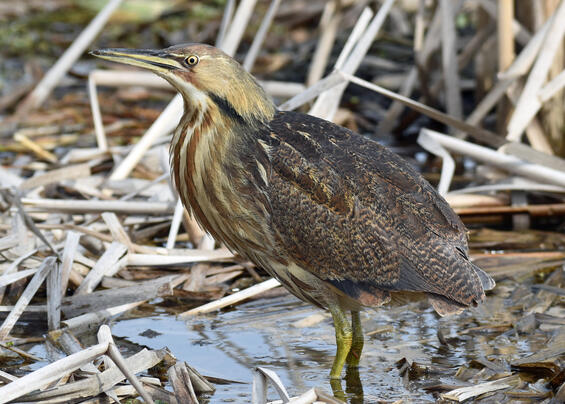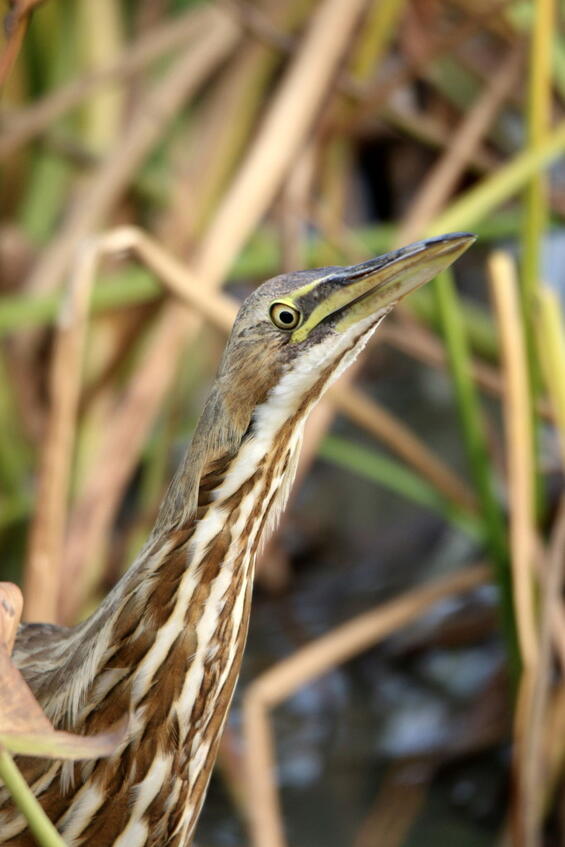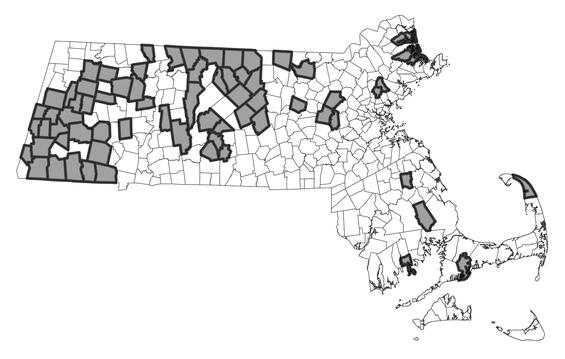- Scientific name: Botaurus lentiginosus
- Species of Greatest Conservation Need (MA State Wildlife Action Plan)
- Endangered (MA Endangered Species Act)
Description

American bittern (Botaurus lentiginosus)
The American bittern is a medium-sized (58-68 cm [23-34 in] long) brown, streaked, heron that spends most of its time hidden among marshland vegetation. Its upper parts are mottled with brown and buff, while the under parts are streaked with brown and white. The short thick neck has a black stripe or patch on each side, and the throat is white with thick black streaks. The top of the head is usually darker than the body, or sometimes rusty. There is a buffy stripe over each of the yellow eyes. The bill, legs, and feet are pale yellow or yellowish-green. Wingspread is from 80-106 cm (32-50 inches) and the black wingtips are conspicuous in flight. The relatively short tail is rounded and mottled brown.
Life cycle and behavior

American bittern (Botaurus lentiginosus)
The American bittern spends most of its time hidden among marsh vegetation. It walks slowly and stealthily. When startled, the bittern assumes what is perhaps its most characteristic stance: standing frozen with the bill pointed skywards, in order to camouflage itself among the reeds, occasionally swaying from side to side with the vegetation as if blown by the wind. When flushed from a marsh, it gives a “kok kok kok” call or a nasal “haink,” its wings flap loosely, feet dangle, and it flies off slowly, but with rapid wing beats. The distinctive call is loud and guttural; the notes sound like an old-fashioned pump, usually in three syllables, the middle one sharply accented; “oonk-a-lunk” or “oong-ka-chook”. Pumping calls are usually heard at dusk, or dawn in spring or early summer.
Courtship behavior is not well understood but is known to include aerial and ground chases. Males slowly stalk females as they display a pair of white fanlike plumes raised over the back and shoulders. Usually, bitterns nest in marshes but may also nest in grassy upland fields adjacent to wetlands. Males appear to be territorial throughout the breeding season and remain in the nest-site vicinity. Males may be polygynous. The female builds the nest and cares for the young. The nest, about 30 cm (12 inches) in diameter, is located either on the ground in dense vegetation or on a platform about a foot above the water. Nest material includes dead reeds, cattails, grasses, and sedges. The 3 to 5 buff-brown to olive-brown eggs are laid at 1-day intervals with incubation beginning with the laying of the first egg. An egg hatches about 24 days after it was laid. Young are fed by regurgitation at the nest for about 2 weeks. The female continues to tend the young for an undetermined length of time after they leave the nest. There is one clutch per year.
Preferred foods include frogs, small snakes and eels, salamanders, crayfish, fish, and occasionally mice and grasshoppers caught on visits to open fields. The American bittern feeds in marshes, meadows, and along edges of shallow ponds, standing motionless with neck outstretched and level bill, eyes focused down into the water, slowly aiming its bill before suddenly darting downward to seize the prey.
Population status
The American bittern is listed as endangered under the Massachusetts Endangered Species Act.
Distribution and abundance
The breeding range of the American bittern extends from Newfoundland west to Manitoba and British Columbia; south to Maryland and west through Oklahoma and Kansas to southern California. American bittern also breeds very rarely in the Gulf States. It winters from the Carolinas south to the Bahamas, Cuba, and Panama, and occasionally as far north as along the east coast of Massachusetts. American bitterns return to Massachusetts marshes in April.

Distribution in Massachusetts. 1999-2024. Based on records in the Natural Heritage Database.
Habitat
The American bittern inhabits freshwater marshes, meadows, fens and bogs dominated by emergent vegetation such as cattails, bulrushes, sedges, and grasses. It may also occur in brackish wetlands.
Healthy habitats are vital for supporting native wildlife and plants. Explore habitats and learn about conservation and restoration in Massachusetts.
Threats
Wetland loss and degradation is the primary modern threat to breeding American bitterns in Massachusetts. Habitat degradation can occur due to the establishment of invasive species, or the compositional shift from cattail and sedge marshes to wooded swamp. American bitterns are particularly sensitive to disturbance, especially noise from roadways, developed areas and construction. They are also vulnerable to mowing when foraging or nesting in hay fields.
Conservation
Maintaining integrity in breeding wetlands is key; especially controlling through invasive species. In situations when breeding is occurring in historically fire-influenced wetlands, introducing a prescribed fire regime to reduce woody encroachment is important. American bitterns are also area sensitive, meaning that they avoid wooded edges and generally require large, open wetlands. Forest thinning at the edge of wetlands has been shown to improve the likelihood that American bitterns will establish breeding territories. American bitterns are also sensitive to disturbance, and therefore all development should be sited away from breeding areas, and the use of machinery should be avoided around breeding sites during the breeding season.
Contact
| Date published: | April 3, 2025 |
|---|